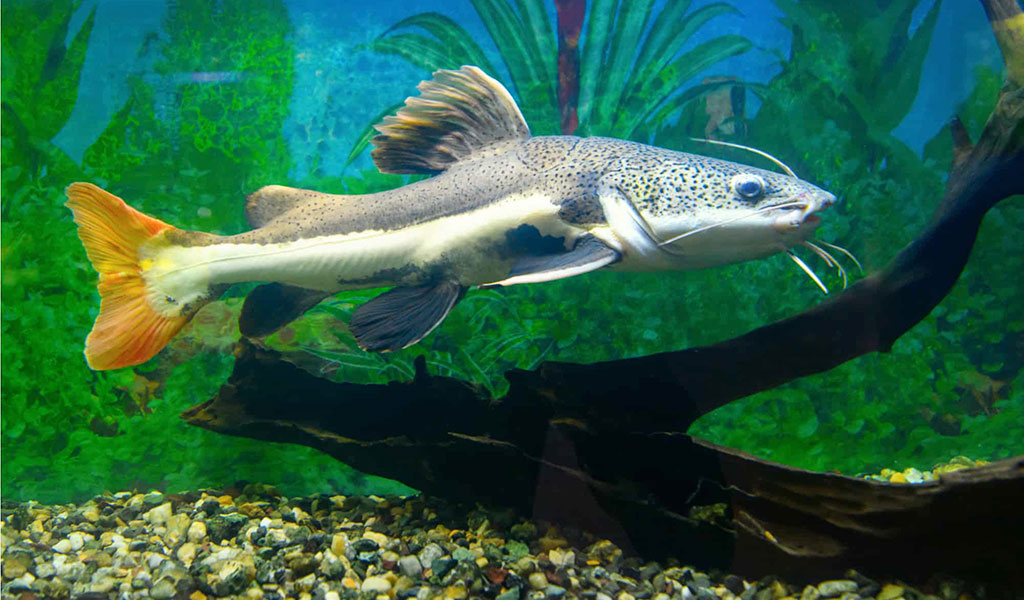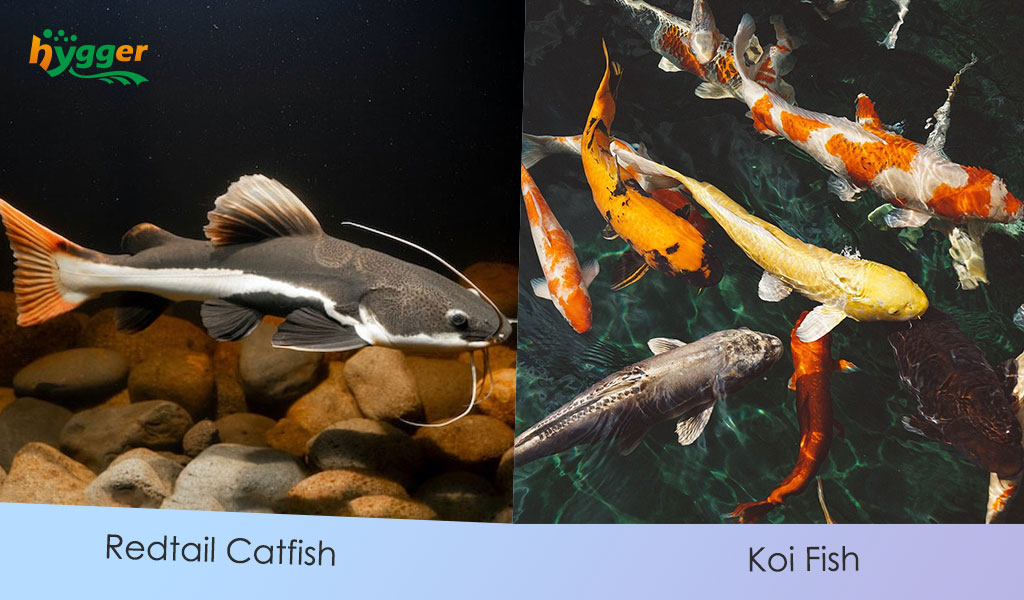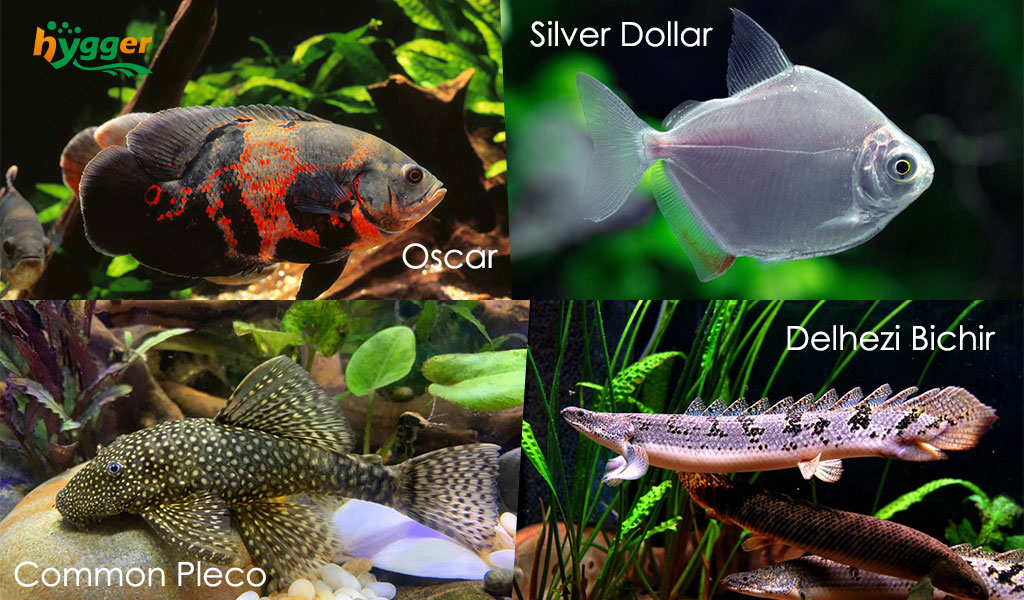Featuring a distinctive red tail and impressive size, the Pirarara Fish captivates enthusiasts. However, to keep the fish healthy in aquariums, you should provide a suitable environment and proper care. In this guide, we will share some pointers about keeping Redtail Catfish, including Asian redtail catfish. Without further ado, let’s dive in.
Content Table
One of the most striking features of the Redtail Catfish is its vibrant red tail fin, which contrasts beautifully with its dark gray to blackish body. Juvenile Redtail Catfish often display a striking pattern of dark spots and stripes, which fade as they mature. As adults, they can grow to be quite large.
Redtail Catfish are primarily bottom-dwellers. Their diet consists mainly of live or dead fish, crustaceans, and other aquatic organisms. Feeding them a varied diet that includes high-quality pellets, and frozen or live foods is essential for their health and growth.
Due to their predatory nature, they require a spacious aquarium or pond with plenty of hiding spots and swimming space. Plus, to ensure good water quality, a well-maintained tank with excellent filtration and regular water changes is necessary.
How big do redtail catfish get
How big do retail catfish get?
Redtail Catfish are known for their impressive size. They can grow to be quite large, making them one of the largest catfish species in the world. Adult Redtail Catfish can grow up to 3–4 feet on average. Generally, juvenile Redtail Catfish can grow rapidly, especially when given a nutritious and well-balanced diet. In a well-maintained and adequately sized environment, some individuals can reach impressive sizes within a few years.
However, it is important to note that the size of Redtail Catfish can vary depending on various factors such as habitat, diet, and environmental conditions. In captivity, where they are typically kept in large aquariums or ponds, they have the potential to grow even larger if provided with proper care and suitable living conditions.

The growth periods of redtail catfish
The growth periods of Redtail Catfish can be divided into several stages, each characterized by different rates of growth. Here are the general growth periods of Redtail Catfish:
- Fry Stage
The fry stage begins from hatching until the fish reach around 2–3 inches in length. During this stage, Redtail Catfish grow rapidly, and their primary focus is on feeding and establishing their basic body structure.
- Juvenile Stage
The juvenile stage typically follows the fry stage and lasts until the catfish reach approximately 8–12 inches in length. This stage is marked by continued growth and the development of their distinctive red tail.
- Sub-Adult Stage
The subadult stage begins when Redtail Catfish reach around 12–18 inches in length and lasts until they approach maturity. Growth during this stage slows down compared to the juvenile stage, but they still experience steady development. The subadult stage is crucial for the catfish to strengthen their bodies and prepare for adulthood.
- Adult Stage
The adult stage is reached when Redtail Catfish reach full maturity, which can occur at lengths greater than 2 feet. At this stage, growth becomes even slower, and the focus shifts more towards maintaining their size and overall health.
Nonetheless, the exact timing and duration of these growth periods can vary depending on various factors, including environmental conditions, diet, genetics, and individual differences. Additionally, Redtail Catfish have the potential to continue growing throughout their lives, although the rate of growth significantly decreases as they reach maturity.
The growth features of redtail catfish
- Fast growth rate
Redtail Catfish are known for their relatively fast growth rate, particularly during their juvenile stages. With a proper diet and suitable living conditions, they can experience significant growth within a short period.
- Size potential
Redtail Catfish have the potential to grow to impressive sizes. In the wild, they can reach lengths up to 6 feet. However, achieving such sizes in captivity requires substantial space and optimal care.
- Growth Variances
The growth rate and potential size of Redtail Catfish can vary among individuals. Factors such as genetics, diet, water quality, tank size, and overall care play a crucial role in determining their growth trajectory.
- Environmental Influence
The environment in which Redtail Catfish are kept significantly impacts their growth. A spacious tank or pond with ample swimming space, appropriate water parameters, and a nutritious and varied diet promotes optimal growth.
- Growth Limitations
While Redtail Catfish have the potential for impressive growth, their growth rates tend to slow down as they reach maturity. Once they reach a certain size, their growth rate may become more gradual.
Can redtail catfish live with koi?
It is technically possible to keep redtail catfish and koi together. But you should consider several factors.
Size compatibility
Redtail Catfish can grow significantly larger than most Koi. The Redtail Catfish can reach an average size of 3–4 feet (about 35–48 inches) in length, while most Koi typically grow to around 12–15 inches. Consequently, to avoid overcrowding and potential stress, you should ensure that the pond or water feature is large enough to accommodate the potential size of both species.

Water quality
Redtail Catfish and Koi have different preferences when it comes to water conditions. Koi thrive in well-oxygenated water with proper filtration systems, while Redtail Catfish prefer slower-moving water with hiding spots. Maintaining suitable water parameters for both species, including temperature, pH, and ammonia levels, is crucial for their overall health.
Feeding habits
Redtail Catfish are opportunistic predators. Their diet primarily consists of live or dead fish, crustaceans, and other meaty foods. Koi, on the other hand, are primarily herbivorous and require a diet rich in plant matter. Ensuring that both species receive appropriate and balanced nutrition can be challenging, as their dietary needs differ significantly.
Aggression & Compatibility
Redtail Catfish are generally peaceful towards other fish species, but their predatory nature may lead to prey on smaller fish, including Koi fry or smaller Koi. Additionally, the territorial behavior of Koi during breeding seasons may cause conflicts with Redtail Catfish. Monitoring their interactions closely and providing ample hiding spots and visual barriers can help reduce potential aggression.
Which fish can be kept with redtail catfish?
When considering tank mates for Redtail Catfish, it is essential to choose compatible species in terms of size, behavior, and water requirements. Next, we will share some great tank mates for Redtail Catfish.
Large and peaceful Cichlids
Some large and peaceful cichlids, like Oscars (Astronotus ocellatus) or Severums (Heros severus), can coexist with Redtail Catfish. These cichlids are relatively robust and can withstand the Redtail Catfish’s presence.

Large Characins
Species like Silver Dollars (Metynnis sp.) or Pacu (Colossoma macropomum) can be compatible tank mates due to their similar size and ability to tolerate the aggressive nature of Redtail Catfish.
Large Plecos
Certain large plecos, such as the Common Pleco (Hypostomus plecostomus), can cohabit with Redtail Catfish as they occupy different areas of the tank and have a peaceful temperament.
Bichirs
Species like Senegal Bichir (Polypterus senegalus) or Delhezi Bichir (Polypterus delhezi) are known for their hardiness and can be kept with Redtail Catfish, provided there is ample space and suitable hiding spots.
Summary
In short, Redtail Catfish are suitable for large aquariums or spacious ponds. They prefer a freshwater environment. The ideal water temperatures range from 72℉ to 86℉ (22-30℃). Also, while they are generally peaceful, their predatory nature may lead them to prey on smaller tank mates. Therefore, compatible tank mates should be fish with similar sizes and a peaceful temperament.



Leave a comment